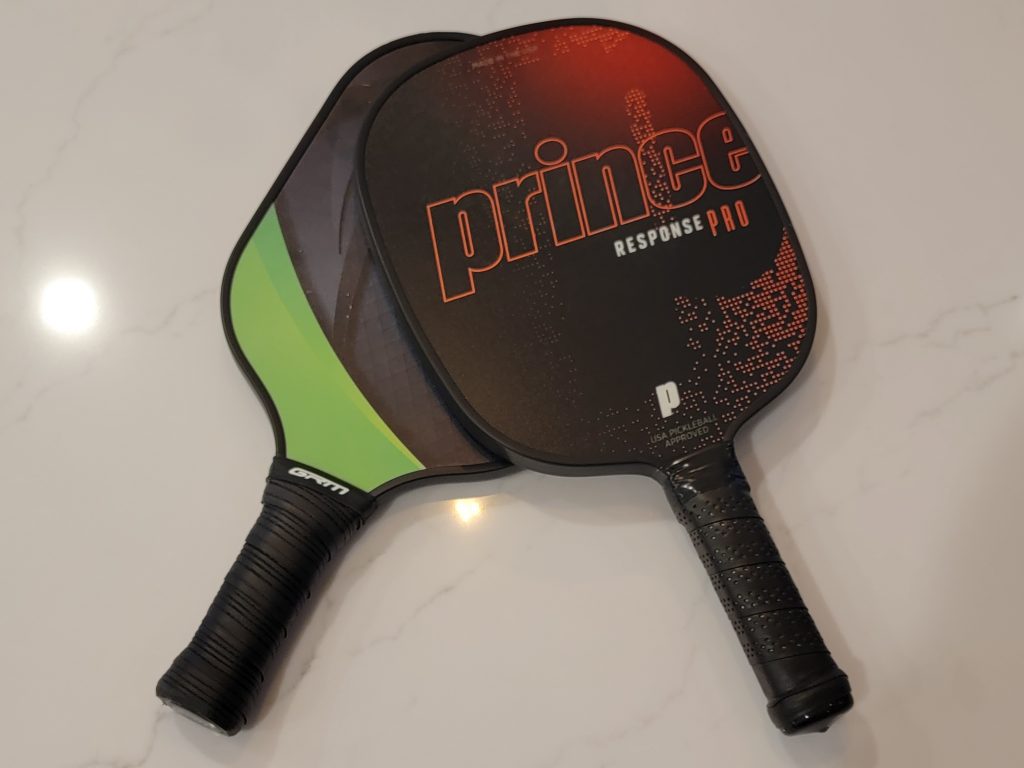Last Updated on November 20, 2025 by Drew Pierce
Pickleball players of all ages understand that improving your reaction time can elevate your game to the next level.
The fierce exchange of volleys. Four players at the line, dripping sweat, ripping forehands and backhands with mind-numbing speed. High-level pickleball can be an exhilarating knife fight. Aside from an insanely cool Erne or ATP, winning a rally like this is the best feeling in pickleball.

But losing? Losing one of these tenacious rallies is a drag.
Here’s the good news. You can increase your reaction time, and I’m going to give you some tips and tricks on how to do it.
Why is increasing your reaction time critical?
Great question. A 40 MPH ball in tennis will travel from baseline to baseline in about 2 seconds. Guess what? At 78 feet, a tennis court is much larger than a pickleball court.
Pickleball courts are 44 feet long. So, a baseline groundstroke that travels 40 MPH (why do I feel like I’m taking the SATs all of the sudden?) will arrive at the opposite baseline in about 1 second.
So, you have half the time to react for baseline groundstrokes in pickleball than in tennis.

I know what you’re thinking. Baseline groundstrokes aren’t even that common in pickleball. The real fast-paced action happens closer to the net. You’re right! And since you’re that much closer (about 14 feet away from your opponents), the ball is coming at you in fractions of a second.
You better be ready for it.
So, how do you improve your reaction time? Let’s take a look at some foolproof ways to develop hand speed.
Here is how to improve reaction time…
How are you warming up?
When I see players warm up, particularly at lower levels, they usually take the court and lazily hit a few cross-court dinks to one another. There doesn’t seem to be much intention about it – they don’t seem to be aiming the ball or trying to force the other person to move. Often, they don’t even switch sides to work on their backhands.
A few quick, lethargic dinks followed by the words, “I’m ready.”
If that’s you, I’ve got some news for you. You aren’t.
Try the world’s greatest pickleball warm up
It’s unbelievably simple but incredibly effective. Stand on one side of the net at the NVZ line (that’s the non-volley zone, AKA the “kitchen” if you’re new to pickleball). Have someone stand on the opposite side of the court.
Now, hit a ball back and forth to each other. Hit the ball while it’s in the air before it bounces (paddle and racquet sports 101 – hitting the ball out of the air is known as a “volley.” Hitting the ball after it bounces is called a “groundstroke.”)
Stand just behind your respective lines, and whack the ball back and forth. Do it for at least five minutes every time you hit the courts.
I think this is the best warm-up to implement before a pickleball game and the best way to improve your reaction time and avoid pickleball injuries.
Drill against a wall
If you can’t find a partner to drill with you, or you’re strapped for time, grab a ball and hit it against the wall. A garage door works well, too. Stick some blue tape about three feet up to mimic a net.
Practice hitting the ball out of the air. Work your forehand and your backhand. You’ll be amazed at how quickly your reaction time increases.
Weigh your paddle
Are you familiar with the old idiom, “it’s a poor carpenter who blames their tools.” It’s mostly true. Let’s apply it to pickleball. “It’s a poor pickleball player who blames their paddle.” Still mostly true.
However, your paddle can slow you down and hinder your hand speed at the line if it’s too heavy.
According to the good folks over at Revolin Sports, a lightweight paddle should clock in between 7.0 and 7.8 oz. Midweight paddles weigh between 7.8 and 8.3 oz. And heavy paddles weigh 8.3 oz and up. Grab your kitchen scale and weigh your paddle.
Sidenote: many players add lead tape to the neck of their paddles to make them heavier and more powerful. If your paddle has lead tape and you’re losing volley battles, consider removing it.
Heavy paddles are terrific for power, but they can slow your hand speed when you’re at the kitchen line. If you’re losing volleys at the line, a heavy paddle might be the culprit. If you bought a cheap paddle that doesn’t indicate how much it weighs, or your paddle is made out of wood, it’s probably over 10 ounces. It’s slowing you down. Time for a new one.
Buy a new paddle
Great. Now I’ve given you permission to buy a new paddle! What a joyous day.
Look, I’m a paddle snob. Aside from the aforementioned Revolin, I’m a fan of Engage Paddles…which I graduated from after embracing Prince paddles in my early rookie days.
This is not a “how to buy a paddle guide,” so I’ll make this snappy. Look for a paddle that’s made in the USA and provides an exact weight statement. A winning paddle will set you back at least $100.

Get in formation
Take a cue from Beyonce and get in formation.
Assess how you’re standing at the line. You want to be standing in what’s known as the “ready position.” This is an athletic stance. Knees bent and loose, your feet shoulder distance apart, your weight on the balls of your feet. Eyes and head up, looking forward, ready to pounce like a jungle cat.
If you’re standing upright with locked knees, and your paddle is by your side, you’re not prepared. Your reaction time is severely hampered. Get in the “ready position” and attack any ball that comes your way.
Hold your paddle at 12 o’clock
When you’re at the line, you want the top of your paddle at roughly chin height. And you want to hold it at 12 o’clock – pointing straight in front of you. 11 o’clock is also acceptable, as you’re more likely to hit a backhand than a forehand.
Okay. Now go hit some balls and improve your reaction time.
